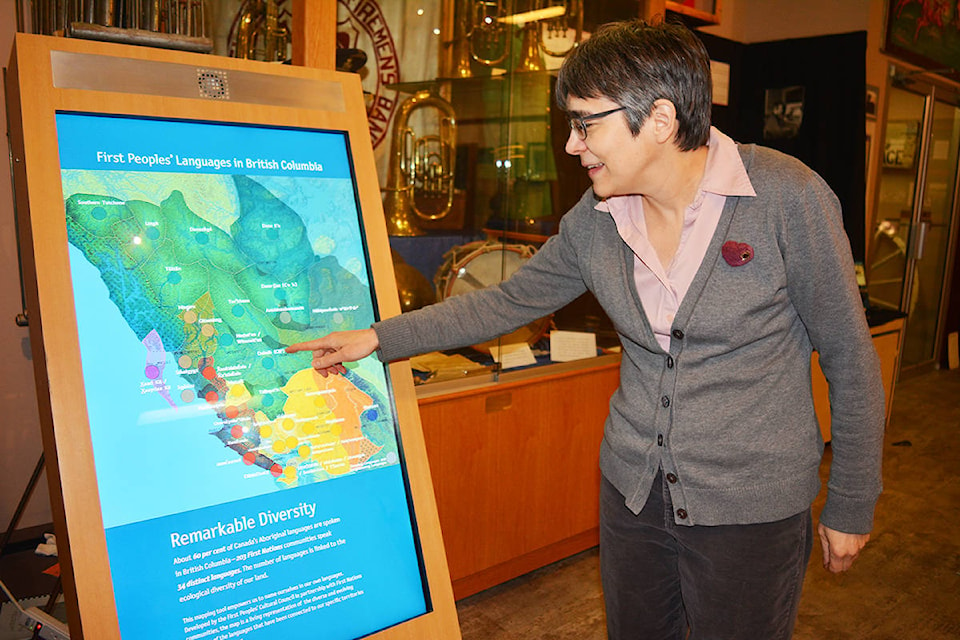“It’s like an invisible line from the heart into the past. I carry it with me everywhere.”
This is how one of the participants in a video in the new Our Living Languages exhibit that opens this weekend at the Quesnel and District Museum and Archives describes how important his language is to him. Language provides many connections, but those connections were severed when First Nations children were taken away and placed in residential schools. Many First Nations communities are working hard to revitalize and preserve their languages, and this exhibit shares how they are doing that all across the province.
Our Living Languages is an interactive exhibit produced by the Royal B.C. Museum in partnership with the First Peoples’ Cultural Council, and it will be at the Quesnel and District Museum and Archives for the next three months. The museum is hosting an opening reception for the new exhibit this Sunday (Feb. 16) from 1-3 p.m.
Our Living Languages celebrates the resiliency and diversity of First Nations languages in the face of disruption and change and gives people a chance to learn about what First Nations communities throughout B.C. are doing to help their languages survive and flourish.
“B.C. is really unique in Canada for the number of aboriginal languages there are, so [the exhibit] is featuring the languages and explaining a bit about how they are at risk because of residential schools, and disruption means there is a low level of fluent speakers in current generations, so what communities are doing to showcase them,” said Quesnel Museum and heritage manager Elizabeth Hunter.
“I think for us, one of the things that is exciting about it is that we do have interactive elements — we do have interviews with Elders, and we have that already, but this showcases that kind of modern-style exhibit where people can come in and navigate themselves and push buttons and see videos or listen to sounds.”
British Columbia is one of the planet’s most linguistically diverse regions, according to the Royal B.C. Museum.
“From a global perspective, it’s known as a linguistic ‘hotspot’ because of the diversity and vitality of the First Nations languages in B.C., 34 of which are spoken in this exhibition,” according to the museum’s website. “Through interactive stations, original First Nations artwork, video, audio and live engagement, Our Living Languages provides visitors with the opportunity to learn more about the history of disrupted languages in B.C., the complexity of these languages, and the people — and entire communities — that are working tirelessly to document and revitalize them.”
According to the exhibit, about 60 per cent of Canada’s aboriginal languages are spoken in B.C. Locally, First Nations in our area speak the Dakelh language.
The Our Living Languages exhibit features large panels explaining the state of languages today, forces of disruption and what communities are doing to preserve their languages.
There are many interactive pieces to this exhibit as well, including a map featuring the 34 languages of B.C., a link to the First Peoples’ Cultural Council FirstVoices website, short video clips with stories about Indigenous languages and a film about language rejuvenation and listening stations, including a collection of oral history recordings done over the years by the Royal BC Museum.
“To integrate it with the work we’ve already done, we’ve got our Elder Stories interviews,” said Hunter, noting many of the women who were interviewed spoke Dakelh.
Because the museum is not open every day, it has partnered with the Quesnel Library to share this exhibit. The library is hosting another large piece of the exhibit, which is called The Cradle of Language and features people talking to young children.
“For much of the time we’re hosting the exhibit, we’re not open on a regular basis, so I thought it was a good opportunity to partner with another organization and get it out more accessible,” said Hunter.
The Our Living Languages exhibit will be at the Quesnel and District Museum and Archives until May 25. While the museum is currently only open Saturdays, groups and schools can book appointments throughout the week, and the museum will start its full operating hours at the beginning of May.
READ MORE: Family Day long weekend features a wide variety of events and activities in and around Quesnel
editor@quesnelobserver.com
Like us on Facebook and follow us on Twitter
